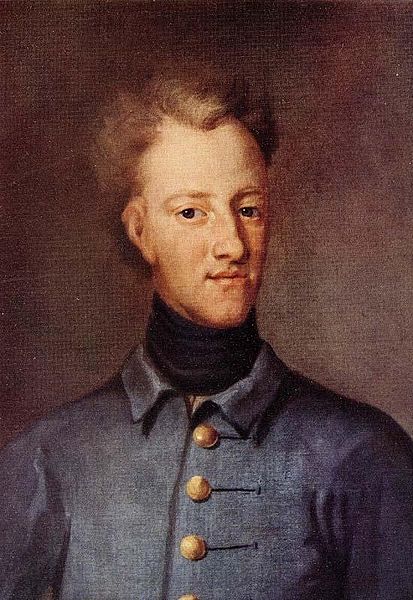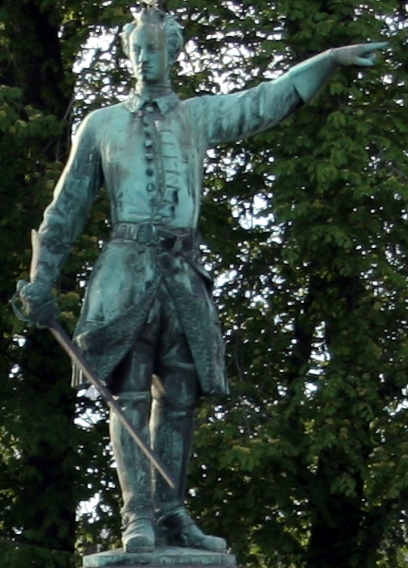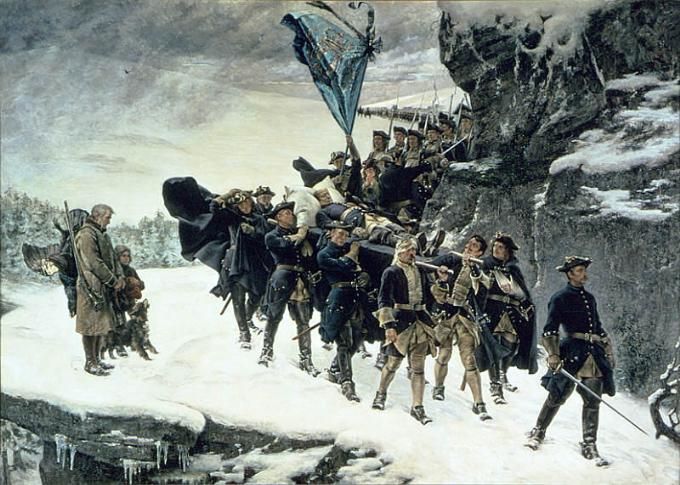<Back to Index>
- Chemist Sir William Crookes, 1832
- Composer Igor Fyodorovich Stravinsky, 1882
- King of Sweden Charles XII, 1682



Charles XII (Swedish: Karl XII, Latinized to Carolus Rex, also known as "Charles the Habitué") (17 June 1682 – 30 November 1718) was the King of Sweden from 1697 to 1718.
Charles was the only surviving son of King Charles XI of Sweden and Ulrika Eleonora the Elder, and he assumed the crown at the age of fifteen, at the death of his father. He left the country three years later to embark on a series of battles overseas. These battles were part of the Great Northern War, fought against Russia, Saxony and Denmark-Norway, countries that had joined in a coalition to attack Sweden. Charles XII was a skilled military leader and tactician. However, although he was also skilled as a politician, he was reluctant in making peace. Charles is quoted by Voltaire as saying upon the outbreak of the Great Northern War, "I have resolved never to start an unjust war but never to end a legitimate one except by defeating my enemies." Although Sweden achieved several large scale military successes early on, and won the most battles, the Great Northern War eventually ended in Sweden's defeat and the end of the Swedish Empire.
The fact that Charles was crowned as Charles XII does not mean that he was the 12th king of Sweden by that name. Swedish kings Erik XIV (1560–1568) and Charles IX (1604–1611) gave themselves numerals after studying a mythological history of Sweden. He was actually the 6th King Charles. The non-mathematic numbering tradition continues with the current King of Sweden, Carl XVI Gustaf, being counted as the equivalent of Charles XVI. Charles, like all kings, was styled by a royal title, which collected all his titles into one single phrase. This was: We Charles, by the Grace of God King of Sweden, the Goths and the Vends, Grand Duke of Finland, Duke of Estonia and Karelia, Lord of Ingria, Duke of Bremen, Verden and Pommerania, Prince of Rügen and Lord of Wismar, and also Count Palatine by the Rhine, Duke of Bavaria, Count of Zweibrücken-Kleeburg, as well as Duke of Jülich, Cleve and Berg, Count of Waldenz, Spanheim and Ravensberg and Lord of Ravenstein. In
1700, Denmark-Norway, Saxony, and Russia united in an alliance against
Sweden, using the perceived opportunity as Sweden was ruled by the
young and inexperienced King. Early that year, all three countries
declared war against Sweden. Charles had to deal with these threats one
by one. Charles's first campaign was against Denmark-Norway, ruled by his cousin Frederick IV of Denmark, which threatened a Swedish ally, Charles' brother-in-law Frederick IV of Holstein-Gottorp. For this campaign Charles secured the support of England and the Netherlands, both maritime powers concerned about Denmark's threats to close the Sound. Leading a force of 8,000 and 43 ships in an invasion of Zealand, Charles rapidly compelled the Danes to submit to the Peace of Travendal in
August 1700, which indemnified Holstein. Having defeated
Denmark-Norway, King Charles turned his attention upon the two other
powerful neighbors, King August II of Poland (cousin to both Charles XII and Frederick IV of Denmark-Norway) and Peter the Great of Russia, who also had entered the war against him. Russia had opened their part of the war by invading the Swedish-held territories of Livonia and Estonia. Charles countered this by attacking the Russian besiegers at the Battle of Narva.
The Swedish army of ten thousand men was outnumbered four to one by the
Russians. Charles attacked under cover of a blizzard, effectively split
the Russian army in two and won the battle. Many of Peter's troops that
fled the battlefield drowned in the Narva River,
and the total number of Russian fatalities reached about 17,000 at the
end of the battle, while the Swedish troop lost 667 men. Charles did not pursue the Russian army. Instead, he turned against Poland-Lithuania,
which was formally neutral at this point, thereby disregarding Polish
negotiation proposals supported by the Swedish parliament. Charles
defeated the Polish king Augustus II and his Saxon allies at the Battle of Kliszow in 1702 and captured many cities of the Commonwealth. After the deposition of the king of the Polish-Lithuanian Commonwealth, Charles XII put Stanisław Leszczyński on the throne. While Charles won several battles in the Commonwealth, the Russian Tsar Peter the Great embarked on a military reform plan that improved the Russian army. Russian forces managed to retake Ingria and established a new city, Saint Petersburg, there. This prompted Charles to attack the Russian heartland with an assault on Moscow, allying himself with Ivan Mazepa, Hetman of the Ukrainian Cossacks.
The size of the invading Swedish army altogether was 77,400 men.
Charles left the homeland, with a defense of approximately 28,800 men. Peter
the Great defeated Swedish forces near the Baltic coast before Charles
could combine his forces, and Charles' Polish ally, Stanisław
Leszczyński, was facing internal problems of his own. Charles expected
the support of a massive Cossack rebellion led by Mazepa in Ukraine but
the Russians destroyed the rebel army before they could aid the Swedish
troops. The harsh climate took its toll as well, as Charles marched his
troops through Ukraine. By the time of the decisive Battle of Poltava,
Charles had been wounded, one-third of his infantry was dead, and his
supply train was destroyed. The king was incapacitated by a coma
resulting from his injuries and was unable to lead the Swedish forces.
Charles had 14,000 men while Peter had 45,000. The battle was a
disaster, and the king fled with a small entourage south to the Ottoman Empire, where he set up camp at Bender with about 1,000 men who were called Caroleans ("Karoliner"
in Swedish). The Swedish defeat at Poltava is considered by some
historians to be the point where the downfall of the Swedish Empire started and the Russian Empire started to rise. The Turks initially welcomed the Swedish king, who managed to incite a war between the Ottomans and the Russians. His expenses during his long stay in the Ottoman Empire were covered from the Ottoman state budget, as part of the fixed assets (Demirbaş in Turkish), hence his nickname Demirbaş Şarl (Fixed Asset Charles) in Turkey. Demirbaş, the Turkish word for fixed asset, is literally ironhead (demir = iron, baş = head), which is the reason why this nickname has often been translated as Ironhead Charles. However, the sultan Ahmed III's subjects in the empire eventually got tired of Charles' scheming and they besieged the Topkapi Palace and
this uprising was called "kalabalik" (Crowd) which after this event
found a place in Swedish lexicon as "kalabalik" referring to uprising.
The Janissaries did not shoot Charles during the skirmish at Bender, but captured him and put him under house-arrest in Constantinople. During his imprisonment the King played chess and studied the Turkish navy. Meanwhile, Russia and Poland regained and expanded their territories. Great Britain, an ally of Sweden, defected from its alliance obligations while Prussia attacked Swedish holdings in Germany. Russia seized Finland and Augustus II regained the Polish throne. Charles succeeded in leaving his imprisonment in Constantinople and returned to Swedish Pomerania on
horseback, riding across Europe in just fifteen days. His efforts to
reestablish the Swedish empire failed. He had two Turkish-style
warships built in Sweden, the Yildirim ("The Lightning") and the Yaramaz or Jarramas ("The Rogue"). Charles's last efforts to reinstate Sweden as an empire were to invade Norway. He first invaded Norway in 1716 with a combined force of 7,000 men, occupied the capital Christiania, today Oslo, and laid siege to the Akershus fortress.
However, the Norwegian forces were intact, and forced a retreat from
the capital at 29 April after inflicting significant losses of men and
material. Mid-May following the retreat from Christiania, Charles
invaded the border town Fredrikshald, now Halden,
in an attempt to take the fortress of Fredriksten. The Swedes came
under heavy bombardment from the fortress and were forced to flee from
Fredrikshald when the town was set on fire. Swedish casualties in
Fredrikshald were estimated to 500. During the siege in Fredrikshald
the Swedish supply fleet was defeated by Tordenskjold at the Battle of Dynekilen. In 1718 Charles once more invaded Norway. The main force consisting of 40,000 men laid siege to the strong fortress of Fredriksten, overlooking the border town of Fredrikshald. While inspecting trenches close to the perimeter of the fortress on 11 December (30 November Old Style), 1718, Charles was killed by a projectile.
The shot penetrated the left side of his skull and exited out of the
right, destroying most of his brain in the process. The invasion was
abandoned, and Charles' body was brought across the border. Another
army corps under Carl Gustaf Armfeldt marched against Trondheim with 10,000 men, but had to make a retreat, during which many of the 5,800 remaining men perished in a severe winter storm. The
exact circumstances around Charles' death are unclear. The most likely
theory is that he was hit by a bullet from a Norwegian musket, but he may also have been killed by a grapeshot bullet from a cannon.
Another theory is that he was killed by a uniform button re-made into a
bullet. This theory is coupled with speculation that he was shot from
the Swedish side (due to the great force of entry by the bullet),
making his death an assassination,
because allegedly he was unpopular in Sweden at the time. A theory is
that the murder was an act of conspiracy made by his sister Ulrika
Eleonora's husband Fredrik who was crowned Fredrik I. It is believed
that the murder was committed by an officer who confessed before he
died in a fever.
Exceptional for abstaining from alcohol and
women, he felt most comfortable during warfare. Contemporaries report
of his seemingly inhuman tolerance for pain and his utter lack of
emotion. The king brought Sweden to its pinnacle of prestige and power
through his brilliant campaigning and victories, although the Great
Northern War eventually ended in Sweden's defeat and end of the Swedish
Empire.
